An extensive cross breeding trial in the Northern Territory has identified a potential $100/head live export market advantage for F1 Brahman/Bos Taurus steers over straight Brahman steers.
For the past six years the NT Department of Primary Industries and Fisheries has been exploring whether crossing Brahman cattle with tropically adapted Bos Taurus genetics will produce cattle that perform well in NT conditions while also improving meat quality and expanding market options for NT producers.
The trial was launched in 2008 in response to concerns that NT producers were too heavily reliant upon the live export market alone, concerns that proved painfully prescient for many producers when live exports to Indonesia were suspended three years later in June 2011.
The researchers launched the trial by joining a common herd of Brahman females to Brahman bulls and Senepol bulls sourced from Queensland.
Senepols were selected as the representative Bos Taurus breed largely because of their polledness, tick resistance and meat quality traits. (However the researchers emphasise that the trial results should not be read as an advertisement for one breed and note that similar results would be expected from other tropically adapted Bos Taurus breeds and/or composites.)
F1 Senepol x Brahman steer and heifer progeny and straight Brahman progeny were run in the same paddocks under the same feed and management conditions to ensure a fair comparison.
The six-year trial to date has compared the performance of both progeny groups in paddock conditions, in feedlots in Australia and Indonesia and has assessed the meat quality and final market value of both groups.
Trial results presented by project leader Tim Schatz from the NT DPIF in recent Beef Connect webinar showed that while both genotypes had performed well in the trial, the F1 Senepol x Brahmans outperformed the straight Brahmans in all categories.
Here is a summary of some of the key results shared by Mr Schatz from the three main areas of the trial:
1. Compare the pre- and post- weaning growth of Brahmans and F1 Senepols in the Top End of the Northern Territory
All weaned male calves from both genotypes were cell grazed for growth studies as one mob on improved buffel pasture and females were placed on native pastures.
Each year the new progeny groups of both genotypes were compared, from an entry weight as weaners at six months of age through to 18 months of age (Not all steers remained to the full 18 month age mark, however, as some were turned off before that age to avoid exceeding the 350kg weight limit for export to Indonesia).
Results of the growth comparisons of both genotypes included:
- Weaning weight: over four years of performance monitoring of each year’s progeny group, the F1 Senepol weaners were on average 21kg heavier at weaning than the Brahmans;
- Growth from 6 to 18 months: After four years of trials F1 Senepol steers put on 12.3kg on average more between June and March (which is when animals had to be sold to avoid going over the 350kg Indonesian live export weight limit).
- At 18 months: At 18 months of age the F1 Senepol steers were on average about 33kg heavier than their Brahman counterparts.
- Market value: On current export prices to Indonesia of $2.70/kg the extra 33kg equates to an additional $89/head.
- Fat cover: The Senepol cross steers tended to be slightly leaner at the same weight.
- Females: The F1 Senepol x Brahman weaning weights were 26kg heavier than the Brahmans, while maiden joining weights as two year olds were 35kg heavier.
- Pregnancy rates were on average 10pc higher in F1 Senepol x Brahman heifers. “Early indications are that the F1s are performing at least as well as Brahman heifers,” Mr Schatz said. The DPIF will put out more results on heifer performance as the ongoing trial continues.
- Polledness: Very few F1 Senepol progeny (<5pc) had horns.
- Vaccination advice: Among several pieces of advice (see webinar video below this article to view all ), Mr Schatz said it was worthwhile vaccinating southern bulls for tick fever. While Senepols had good tick resistance, they were just as susceptible to tick fever as British breeds and so it was worthwhile ensuring they have been vaccinated for tick fever.
2. A comparison of the growth and meat tenderness of Brahman and F1 Senepol x Brahman steers
Do the crossbred animals produce more tender meat?
In March 2013 all steers from both genotypes that were approaching the 350kg cut off weight for export to Indonesia were sold. On average the F1 steers were 38kg heavier at that time. The heavier weights at that age meant 54pc of the F1 steers had achieved live export weights by March 2013 compared to 16pc of the Brahman steers.
The remaining steers – those not sold for live export – were selected for domestic feedlot and meat quality research in Australia.
In July 2013 the researchers trucked 25 steers of each genotype to Smithfield Feedlot at Proston. The average weight loss over the 3300km, five day journey was 12pc from the full paddock weight or 9pc from the fasted overnight weight.
All steers were fed on the same commercial ration in the same pen for 73 days.
There was no significant difference in weight gain between the two groups, with the F1s recording an Average Daily Gain (ADG) of 1.84kg and Brahmans 1.82kg.
After 73 days on feed the steers were slaughtered at Dinmore and their carcases were hung overnight with MSA assessment conducted the following morning.
The carcases were boned out and a whole strip loin was collected from each animal for meat quality studies at UNE. The strip loins were individually cryovaced, boxed and chilled overnight and then sent to the UNE meat science lab where they underwent meat quality testing.
Key results included:
MSA boning groups: On average the F1 Senepols graded two boning groups lower than Brahmans. THe F1s averaged 6.3 and Brahmans 8.3 (Boning groups of 9 or lower attract MSA premiums).
- Hump height: Mr Schatz said that much of the difference between the two genotypes in boning groups was due to hump height. The average hump height of the Brahman steers was 138mm compared to F1 Senepols with 88mm.
- Meat tenderness: The F1 Senepol meat was significantly more tender, with 0.44 kg less shear force required to cut the meat compared to the Brahmans (3.43 kg for F1s compared to 3.86 kg for Brahmans)
- Both tender: It is worth noting that both genotypes performed well on meat tenderness – both had average shear force values of less than 4 kg, the level below which beef is considered to be tender.
Mr Schatz said both genotypes grew well in the feedlot, both graded well in MSA and both tested well for meat tenderness.
He said the results indicated that Brahman cattle with good meat quality can be produced by production systems that give good growth rates and minimise age at slaughter.
“However this may not be possible on many extensive properties in northern Australia where growth grates are low. In these situations crossbreeding may be required to improve meat quality.”
Advantages of F1 Senepols were that they graded better for MSA mostly due to lower hump height and had significantly more tender meat, and effectively offered producers ‘more margin for error’ in the event of a poorer season or shorter time in the feedlot.
The conclusion of this section of the trial was that cross breeding with tropically adapted Bos Taurus genetics appeared to be a good way for northern beef producers to produce cattle that perform as well as Brahmans in the NT environment while expanding marketing options for NT producers, because they perform well in both Indonesian live export market and Australian domestic feedlot conditions.
3. Indonesian feedlot comparison
Mr Schatz said that despite the production and meat quality advantages offered by cross breeding with tropically adapted Bos Taurus cattle, some northern cattle producers were reluctant to embrace crossbreeding due to a perception that Indonesian lot feeders preferred high grade Brahman cattle and cattle buyers will pay less for crossbred cattle.
The third part of the study was aimed at testing whether these perceptions where true.
The researchers formed a collaboration with Elders Indonesia to compare the performance of F1s and Brahman steers in their Lampung Feedlot and Bogor abattoir.
Steers at suitable export weight for Indonesia were selected in February 2014, with 57pc of F1 steers achieving that weight and 24pc of Brahmans.
The average induction weight of the F1 steers was 312kg and Brahmans 308kg. The steers were managed together under normal feedlot management for 121 days on a normal Indonesian feedlot ration comprising tapioca waste, copra meal, palm kernel meal, distiller’s grain, Napier grass and molasses.
The steers were then slaughtered at the Elders abattoir at Bogor and boned out for the restaurant market.
Results included:
- Over the 121 days on feed the F1s produced a higher ADG of 1.71kg per day, compared to Brahmans with 1.54kg, with the F1s putting on 21.6kg more weight during the time on feed than the Brahmans.
- The final average P8 fat depth was about the same in both genotypes even though the F1 Senepols were close to 25kg heavier. This has positive implications for Indonesian lot feeders because it means cattle can be fed to heavier weights without becoming over fat.
- The average boning room yield was 2.4pc higher for the F1s.
Mr Schatz said the Indonesian feedlot operators were very happy with the crossbred cattle, with the additional meat tenderness giving them the additional option of being able to feed them for a longer period to target the restaurant market.
“In summary we found that F1 Senepols offered production advantages to Indonesian feedlotters as well as Australian cattle producers,” Mr Schatz said.
So what about the extra $100 per steer?
When Mr Schatz presented the recent Beef Connect webinar, he asked whether producers would be interested in earning an additional $100 per steer.
He concluded the presentation by illustrating that such a result was far from pie in the sky thinking.
Following the trial PT Elders Indonesia manager Dick Slaney stated that the strong performance of the F1 cattle would warrant a premium for such cattle in future.
The following calculation demonstrates how achieveable the additional $100/head goal is:
Extra weight at sale at 18 months of age = 33kg x $2.70/kg = $89.10/hd
Premium (for adapted B.Taurus crossbred) = 330kg @ 0.05c = $16.50/hd
Total: $105.60/hd
In an earlier Beef Central article focusing specifically on the Indonesian section of the trial, Mr Slaney also stressed that it was dangerous to lump all Indonesian feedlot customers into one box in terms of breed preferences.
“Indonesia has many importers, and each may have different opinions on crossbreds,” he said. “Too many Australian stakeholders try to lump them all into one, whereas in truth, every single importer has different likes and dislikes because that’s the way the market sees it.”
To view Tim Schatz’ recent Beef Connect webinar presenting the results of the trial click on image below

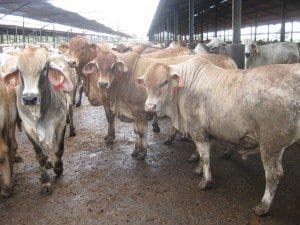
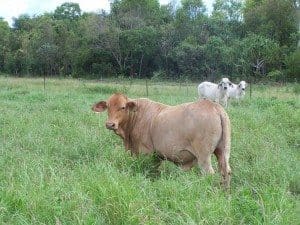
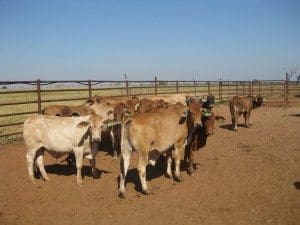
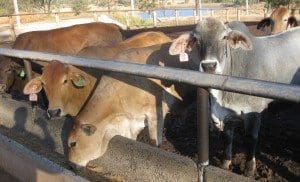
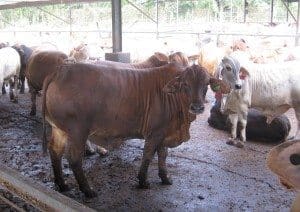
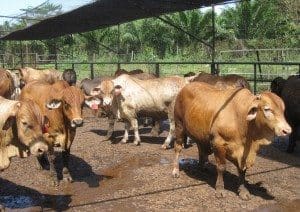



Buenas
Just imagine if you used Euro cross instead. Imagine the extra dollasrs then